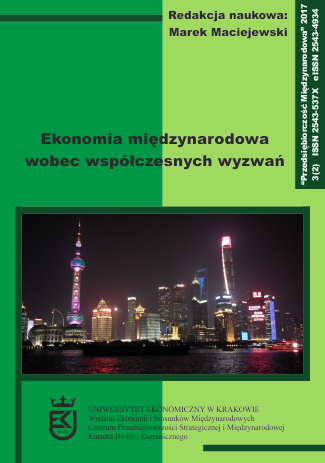An enterprise’s financial stability and its sustainable growth. A risk-based perspective

Abstract
Rating of major factors affecting the financial stability of an enterprise; discussion of a model of sustainable growth of an enterprise with a focus on growth optimising. The core problem of this paper is the financial stability of an enterprise considered as an entity conducting business activity. The paper uses in a research the analysis and assessment of an optimum model of a sustainable growth of an enterprise. Research hypothesis: risk is a essential building block of the sustainable growth idea. The reasoning unwinds around the following five fundamental themes: (i) Description of a sustainable growth of an enterprise; (ii) The essence of an enterprise’s stability; (iii) Comparison of an enterprise’s sustainable growth and its stability; (iv) An enterprise’s sustainable growth in a risk-based perspective; (v) Analysis and assessment of a model of an enterprise’s sustainable growth. One may use sustainable growth model to show how the steady growth rate for an enterprise changes in response to changes in the decisions made at the enterprise. This enables the management to track the effect of strategic decisions on the dynamics of the enterprise’s growth rate. This also supports the creation of the enterprise’s policy by promoting an aggressive and more risk-laden strategy, which would ensure a growth rate above the sustainable growth rate; or a highly conservative strategy, which, however, would not ensure even the sustainable growth rate, satisfactory to the shareholders and prospective investors. The implementation of sustainable growth principles requires the organisation to make a significant effort to present its product or services offering on the one hand, and to implement raw material procurement procedures, use best manufacturing practices and create modern distribution systems on the other. A material role in the process is played by risk as a essential building block of the sustainable growth idea.
Keywords
financial stability, risk, sustainable growth, model, value
References
- Altman, E. (1993). Corporate Financial Distress and Bankruptcy. New York: Wiley & Sons.
- Altman, E. (2002). Bankruptcy, Credit Risk and High Yield ‘Junk’ Bonds: A Compendium of Writings. Oxford: Blackwell Publishing.
- AON (2007). Global Corporate Marketing and Communications. Sustainability – Beyond Enterprise Risk Management. Retrived from http://www.aon.com on 15 October 2016.
- Błach, J., Gorczyńska, M., Mitręga-Niestrój, K., Puszer, B., Wieczorek-Kosmala, M., & Znaniecka, K. (2012). Oddziaływanie globalnego kryzysu finansowego. Perspektywa przedsiębiorstwa, Warszawa: CeDeWu.
- Bodie, Z., & Merton, R.C. (2003). Finanse, Warszawa: PWE.
- Capiga, M., Gradoń, W., & Szustak, G. (2010). Sieci bezpieczeństwa finansowego, Warszawa: CeDeWu.
- Carroll, A.B., & Buchholtz, A.K. (2000). Business and society: ethics and stakeholder management. Mason: South-Western College Publishing.
- Chernavsky, K. (2011). Financial instability of enterprise as the main obstacle hampering development in turbulent environment. Journal of Economic and Social Development, 1(1), 123-134.
- Emery, D.R., Finnerty, J.D., & Stowe, J.D. (2004). Corporate financial management. Upper Saddle River: Pearson Education International.
- Ferrell, O.C., Fraedrich, J., & Ferrell, L. (2002). Business ethics: ethical decision making and cases. Boston-New York: Houthton Mifflin Company.
- Gasiński, T., & Pijanowski, S. (2011). Zarządzanie ryzykiem w procesie zrównoważonego rozwoju. Podręcznik dla dużych i średnich przedsiębiorstw. Warszawa: Ministerstwo Gospodarki.
- Gilyarovskaya, L. (2006). Commercial organizations financial sustainability, it’s analysis and diagnostics. Moscow: Unity.
- Gorczyńska, M. (2013). Stabilność finansowa a zrównoważony rozwój przedsiębiorstwa. Zarządzanie i Finanse, 2, 99-110.
- GreenBiz (2012). Six key trends in corporate sustainability. An Ernst & Young survey done in cooperation with GreenBiz. Retrived from: http://www.ey.com on 15 October 2016.
- Jajuga, K., & Jajuga, T. (1999). Inwestycje — instrumenty finansowe, ryzyko finansowe, inżynieria finansowa. Warszawa: PWN.
- Jurkowska-Zeidler, A. (2008). Bezpieczeństwo rynku finansowego w świetle prawa Unii Europejskiej. Warszawa: Oficyna Wolters Kluwer Business.
- Kaplan, R., & Norton, D. (2007). Using the Balanced Scorecard as a Strategic Management System. Harward Business Review, 85, 2-14.
- Key, S. (1999). Toward a new theory of the firm: a critique of stakeholder theory. Management Decisions, 37(4), 317-328.
- Kiedrowska, M., & Marszałek, P. (2002). Stabilność finansowa — pojęcie, cechy i sposoby jej zapewnienia. Cześć I, Bank i Kredyt, 03, 20-34.
- Kovalev, V.V. (2002). Financial Analysis: Methods and Procedures. Finansi i Statistika, 2, 550-565.
- Neale, B., & McElroy, T. (2004). Business finance, a value-based approach. Prentice Hall. Harlow: Pearson Education Ltd.
- Nowak, E., Pielichaty, E., & Poszwa, M. (1999). Rachunek opłacalności inwestowani. Warszawa: PWE.
- PKN (2012). Zarządzanie ryzykiem. Zasady i wytyczne. Warszawa: Polski Komitet Normalizacyjny.
- Pohle, G., & Hittner, J. (2008). Attaining sustainable growth through corporate social responsibility. New York: IBM Institute for Business Value.
- Pomykalska, B., & Pomykalski, P. (2007). Analiza finansowa przedsiębiorstwa. Warszawa: PWN.
- Rogall, H. (2010). Ekonomia zrównoważonego rozwoju. Teoria i praktyka. Poznań: Zysk i S-ka.
- Skowron, P. (2015). Kategoria ryzyka w koncepcji zrównoważonego rozwoju przedsiębiorstwa. Prace Naukowe Uniwersytetu Ekonomicznego we Wrocławiu, 376, 68-72.
- Smith, N.C., & Lenssen, G. (2009). Odpowiedzialność biznesu. Teoria i praktyka, Warszawa: Studio EMKA.
- Thomsen, S. (2004). Corporate values and corporate governance. Corporate Governance: The international journal of business in society, 4(4), 29-46.
- Welch, J., & Welch, S. (2005). Winning, New York: HarperBusiness Publisher.
- Wojtyna, A. (1995). Polityka ekonomiczna a wzrost gospodarczy. Gospodarka Naro-dowa, 6, 3-9.
- Woźniak-Sobczak, B. (2001). Aktywne i pasywne inwestycje przedsiębiorstwa. Katowice: Wydawnictwo Akademii Ekonomicznej im. K. Adamieckiego w Katowicach.